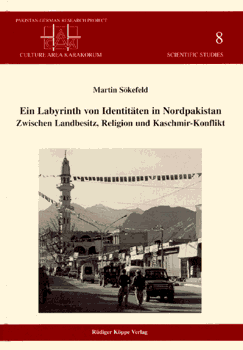


The topic of this publication, written in German and including an English summary, is the description, analysis and discussion of discourses and processes of identity in Gilgit, Northern Areas of Pakistan. Gilgit is a town of about 40,000 inhabitants situated in the high mountain area of Karakorum. In economic, administrative and political respect, it is the central place of the Northern Areas. Being formerly governed by the British and the Maharaja of Jammu and Kashmir, the area is now administered by Pakistan, but due to the pending Kashmir dispute the Northern Areas and Gilgit are not formally part of Pakistan’s state territory. The plural society of the city of Gilgit is a field for studying the complex labyrinth of identities.
This work presents a great number of different identities of different levels, labeled by different ethonyms, marking off different kinds of groups or categories. Accordingly, the study focusses on discourses, interpretations and actions of individual persons. The purpose of the present publication is not an encyclopaedic compilation and description of identity groups in Gilgit but rather the exploration and analysis of relations and processes between groups and between the individuals that relate themselves to such groups.
This book is an attempt to clarify the complexity of identification processes in Gilgit. Sökefeld went to Gilgit with a view to define identity groups among the local population by analysing local discourses. Instead of clear-cut groups, however, he was to find nothing but a ‘labyrinth of identities’ paved with contradictory and paradoxical ethonyms and qualities attributed to the groups thus labelled. These turned to be closely linked to local conflicts and the repercussions of supra-local conflicts in Gilgit. [...] This book is an excellent contribution to the understanding of plural societies. I particularly appreciated its sense for individual human concerns and its sympathetic scepticism towards theory. It is certainly worth reading for Ladakh scholars, since the social and political situation in Ladakh – though by far not as complex as in Gilgit – offers many parallels.
Thierry Dodin in Ladakh Studies, 10 (Summer 1998), 32f
© 2026 by Rüdiger Köppe Verlag – www.koeppe.de